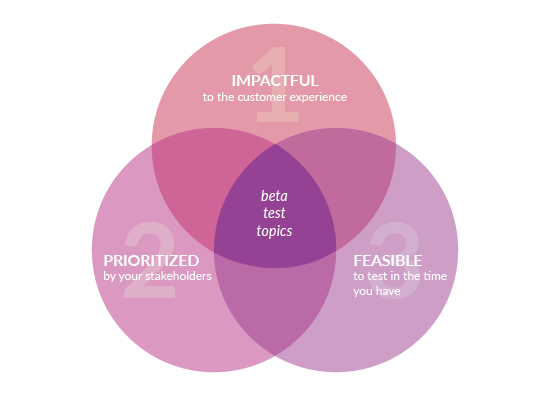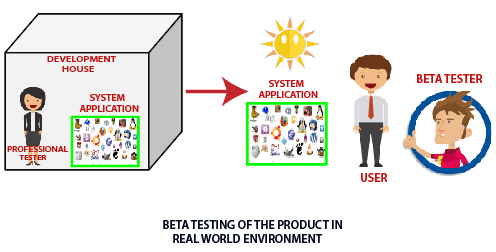12 Best Practices for Beta Testing That Strengthen Software Quality Assurance


Are you confident about your development and done with in-house testing? If yes, congratulations; you are one level up to strengthen your software quality assurance. After completing the in-house testing or alpha testing, developers move to beta testing, which helps them to know whether the software is market competitive or not.
Using the beta testing approach, developers and testing engineers come to the point when they know users’ need for more functionalities and features. Beta testing is a bit risky and inuring compared to alpha testing.
When conducting alpha testing, the development and QA team plan what strategy should be impactful. Moreover, they have multiple options, either manual or automated testing. They don’t fear any circumstance as the development team is here to sort out all bugs and errors. They find out while testing manually or automatically.
Read More: 10 Successful Automation Testing Tools For Efficient Software Quality
In beta testing, you don’t have a single path or direction that you can follow to test your software in the free world. Every product has its way of beta testing and tailor-made strategies planned before beta testing.
If you are unsure what to do for beta testing, you can hire Software Quality Assurance company services to plan your beta testing. They provide all resources from the initial to the last stages. Like MMCGBL, we are offered full-fledged services so that deployment is faster. Moreover, we are concerned about the quality product. We also provide every type of testing after completion of development to get maximum satisfaction.
Let’s dive into beta testing, why it is crucial, and what best practices testers use to verify 100% software quality assurance.
What is Beta Testing?
Beta testing is the testing in the real world of your original product that you expect to deliver to your intended audience. Imagine your software is all set to release, and you just give it a review with a few groups of people before launching in the whole market. Make sure you have added all features and functionalities that you planned.
Here are a few more specifications your product must meet to participate in the beta test.
- The picked audience for beta testing must be relevant to your target audience and understand the need for your product.
- Ensure your beta testing product avoids any glitches so that users can experience stable software.
- It must be introduced in a bona fide environment to get the actual feedback from the real users.

5 Types Of Beta Testing For Software Quality Assurance
Here are the five types of beta testing that you need to know!
Open Testing
In open beta testing, users are not limited and are open to the public for use. It is also called public testing. Users can ask for an executable file or directly download the app. An example of an open beta test is the Google Chrome beta testing app.
Closed Testing
This is known as closed beta testing, when businesses impose app limitations. Only people who have received particular invites from the organization can download and utilize the app to conduct beta tests. For instance, although Google Tasks Mate is a public program, you cannot use it without a Google invitation.
Technical Testing
Performing a beta test with tech-savvy participants is known as technical beta testing (mostly a group of users inside the organization). This test seeks to find intricate issues and deliver detailed test results to the engineering team. These participants are tolerant of minor problems. Thus they concentrate on finding elusive bugs. These test takers are ready to finish the exam regardless of any difficulties.
Focused Testing
As the name implies, teams conduct a targeted beta test when they want input on a particular feature. By putting the product on the market, the group gathers customer feedback.
Marketing Testing
Gaining media attention for your product is the primary goal of marketing beta testing. You may analyze your marketing channels with this kind of beta test.
Read More: What is Automation Testing? 7 Benefits of Implementing Automation Testing
12 Best Practices For Beta Testing

Prior Set Objectives
It would be beneficial to have a beta testing strategy with clearly defined goals for success, failure, and areas that require a full rethink. Because you could start to justify feedback, which contradicts the aim of a beta test to assist you in critically examining the input you get from it, you should choose these objectives in advance rather than on the spot.
Gather Ideal Customer Profiles
It’s crucial to have ideal customer profiles (ICPs). Choosing your users based on your primary consumer criteria might be beneficial. Having non-ICPs perform your tests is unproductive since their input may lead you to develop features that don’t satisfy your ICPs’ demands.
Acquiring Long-Term Clients
The acquisition of long-term customers is crucial for the company’s future expansion. Beta testing with multiple user groups, especially those outside your intended demographic, is a useful customer acquisition approach as you grow to extend your audience.
Create Standard & Expectations
Frequently, beta testers will conduct tests in accordance with their knowledge. Nevertheless, depending on how tough the market and product are, the tests could need to be improved. To achieve the greatest results in your test, it is crucial to consider the typical important use cases, establish standards and expectations, and ensure your testers adhere to them.
Create a Sincere Group of People
Please make sure the beta testers for your app are aware of the objectives you have for testing it. Make a thorough strategy with a deadline to assist them in accomplishing this. When you get the feedback, thoroughly read it and note any unfavourable comments.
Focus on Feedback
With business software, it is usually crucial to have a team of customer advocates that can offer advice depending on user needs. Beta tests must incorporate groups other than the customer advocates. Getting quick feedback and implementing the right action should be grateful for your product.
Give Beta Tester Rewards
Giving your beta testers incentives is a terrific approach to keep them engaged. You can give away numerous things, including money, rewards, and public acclaim.
Engage Potential Stakeholders
There will always be coworkers enthusiastic about the new software and ready to provide their opinions and observations. Target users according to your specialization when it pertains to them. Give them unrestricted use of your software in return for their insightful input.
Rotate Group members
Make sure not to utilize the same people for each beta test of a major feature. False positives might result from this, which occurs when your beta testers appreciate the new quality but your target audience doesn’t. Your beta testers’ input will remain consistent if you rotate them.
Build Real-World Testing Scenario

The beta testing crew should try to represent a diverse community while conducting tests in real-world conditions. When choosing users, the testing team must include people from various cultures, genders, socioeconomic backgrounds, ages, education levels, and physical and mental abilities. This strategy will develop items ready for the market and have a significant effect.
Read the guide: Software Quality Assurance & Testing – Process, Techniques, And Types.
Advantages Of Beta Testing To Ensure Software Quality Assurance
- In beta testing, the customer’s needs come first.
- It lessens the possibility of a failed product. This is accomplished through user validation.
- It may be used to test the infrastructure after launch.
- It aids in finding bugs that the software developers missed.
- Customer satisfaction rises due to improved product quality thanks to user input.
Beta testing is more crucial than ever right now. Although there are many various reasons to beta test, bear the following objectives in mind:
Customer Feedback
You have added features and functionalities. Now your clients will suggest to you what more features you can add. It is a perk of conducting Beta testing and generating ideas to optimize your application.
Software Quality
By conducting beta testing, you can evaluate its performance because multiple users use it and experience software differently.
Software Usability
Beta testing also helps to understand how flawless users use the software regarding its design, features, etc. Does it give the ideal responsive experience to different device users if it is an app?
Cost Effective & Save Time
In case your software or app does not meet the standard of audience needs, you will get to know about the initial stage, and ultimately, you can save money and time.
Make Money at Initial Stages
Increase conversions and income by increasing usability and offering more value to users. If your product hits the six at the initial stages, you may get a lot of referrals and potential clients before throwing it into the big market.
Read More: What is SQA Testing? Different Activities involved in Software Quality Assurance
Bottom Line
I hope you will get the point of beta testing and are you ready to make a strategy for it? And if you are the one who is planning to build an app or software, then no regret. You will get your desired software. Hire professionals to build your app, and if you are struggling to get a trusted software development company, then we will give you our hands!
MMCGBL is one of the leading companies where we deliver full stack development services from designing, developing, testing, and launching services. Whatever you need, we are here to fulfil all your requirements. Consult us and get ideas for your new project.
FAQs Related To Beta Testing (SQA)
Your beta test’s duration will rely on your goals. Many trials last between three and five weeks. You must, however, take into account unavoidable delays. Have a fallback strategy in place.
After completing the beta testing, you have to oversee all the feedback, sort out the major requirements, start working on it and finish it by the specified deadline. There are multiple steps further to launch it publicly.
The size of your project will determine how many beta testers you need. If the project is modest and the team is just 20 people or less, you may run beta tests with 10–15 testers. You will require more than 500 beta testers if your project is enterprise-level and your team size exceeds 1000.



